*This post may contain affiliate links. Read more »
Buko Pandan is like the Philippines stepping up to the darned plate to answer the siren song of Vietnamese che ba mau and Malaysian bubur cha cha. And with all the gosh darned pretty colors and goodies in the galaxy, stepping up to the plate and knocking it outta the dang park is just what the heck this Filipino jello dessert recipe does!
Find out why one of the easiest vegan dessert recipes on my blog is also one of the most popular with my recipe testers.


Enter your email & I'll send it to your inbox. Plus, get great new recipes from me every week!
By submitting this form, you consent to receive emails from Cinnamon Snail.
Jump to:
🥰Why you'll adore this buko salad recipe
✊ Vegan AF, SF & GF: Like all my vegan Filipino recipes, it's free from animal products, which means it’s also cholesterol free. There’s no soy, table cream, or buko pandan sweetened condensed milk in it either, and it just happens to be one of my completely GF vegan recipes too!
🧪 Agar Agar Magic: Using agar agar instead of gelatin not only makes this dessert vegan and kosher but also ensures a perfectly firm jelly that holds its shape.
✅ Tested and Approved Worldwide: Like all the vegan recipes I share here, I tweaked the recipe like crazy before sharing it with a crew of over 350 recipe testers from around the world who replicated it successfully in their home kitchens.


🤫 Learn the secrets for perfect vegan Filipino meals
This guide to my most popular plant-based recipes from the Philippines is 100% FREE, & you'll love the actual heck out of it 🥰
🤷♀️ Salad? For Dessert?
Give me a break. What’s next? Seitan fried chicken for breakfast? While Buko Pandan is often considered a salad (because it has all kinds of fun bells and whistles mixed together), it really has more of the textures you might love about desserts like bubur sumsum and kolak biji salak.
This Buko Pandan recipe combines the magical forces of tender young coconut strings, bouncy pandan jelly, chewy sago pearls, sugar palm fruits, and a rich coconut cream dressing. Whether you're new to Filipino desserts or a seasoned fan, this recipe is guaranteed to knock your darned socks right off.
The name "Buko" means young coconut in Tagalog, while "Pandan" refers to the aromatic extracted screwpine leaves that are used to flavor the jelly.
What sets this recipe apart is its simplicity, the depth of flavor and the fact that it’s also completely vegan and gluten-free, making it an easy win for potlucks and family get-togethers. With just a few ingredients and easy-to-follow straightforward steps, you’ll nail this better than any hawker, and know it’s made naturally, without artificial flavors or any such nonsense.
🥥 Buko salad ingredients
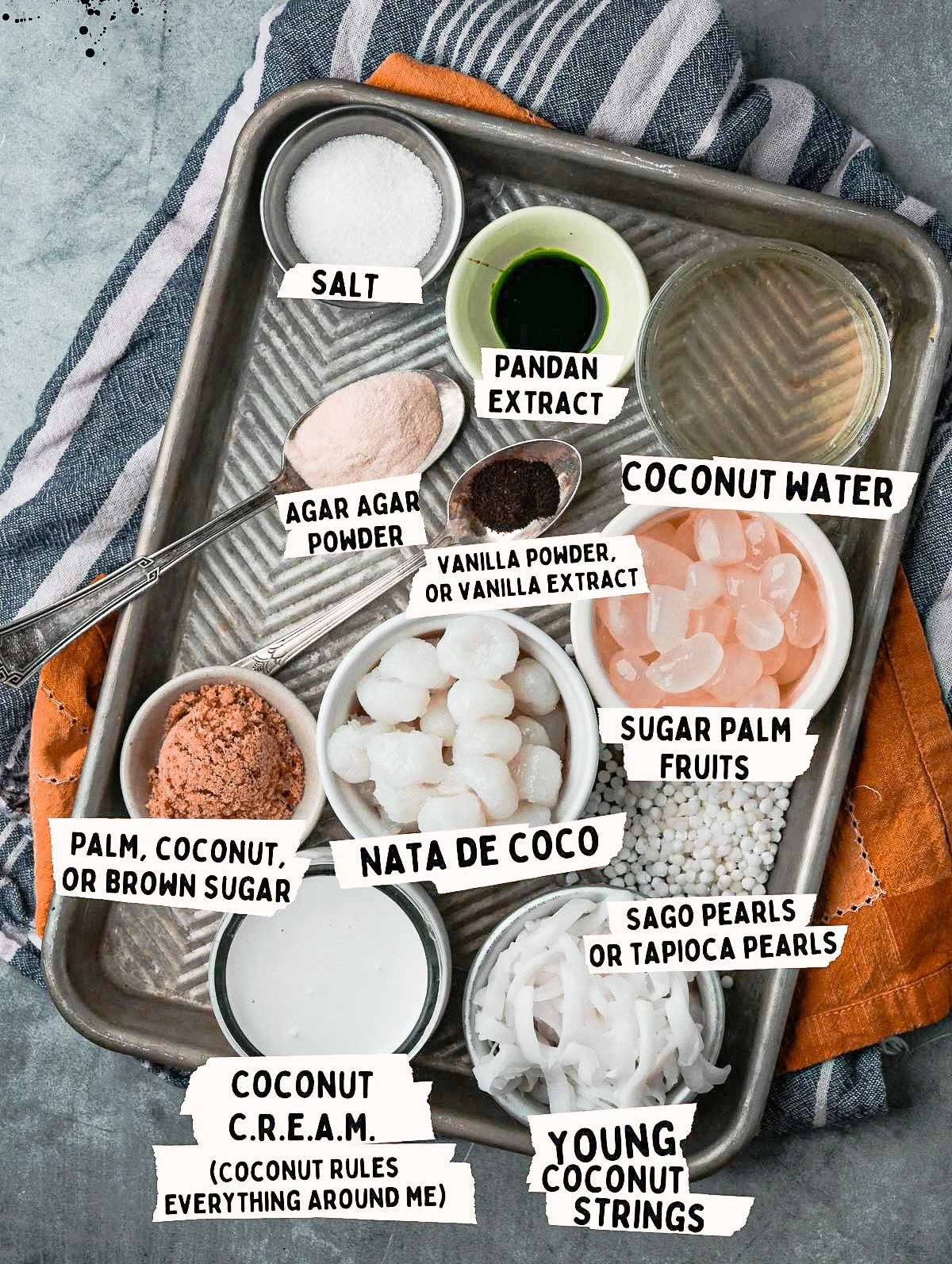
Coconut Water
Known as "buko juice" in the Philippines, coconut water is not only refreshing but also packed with electrolytes, making it a great hydrating ingredient. If you are in the USA, the best options are Harmless Harvest coconut water, and Raw Generation if you can find it. Otherwise, if you live somewhere with fresh coconuts growing, use the water from young coconuts only. You can use the meat from those same coconuts in this recipe, or to make the famous banana leaf-wrapped Filipino dessert, Tupig.
Pandan Extract
Natural pandan extract that doesn’t contain artificial colors and flavors is hard to find, but it’s out there! This extract is a staple in Southeast Asian desserts such as roti kukus and putu ayu. If you can’t get real pandan extract, don’t settle for the artificial stuff!
The other option is to take the coconut water used in the pandan jelly and simmer it with a few fresh pandan leaves. Then, you can blend it and strain out the ground pandan leaf before cooking with the agar agar. Don’t be scared, my dear love! This is the same method I use for making desserts like ondeh ondeh on the regs!
Agar Agar Powder
Agar agar, a gelatinous substance obtained from seaweed, is the vegan alternative to jelly powder and is known for its firm setting properties, which I rely on all the time for desserts like coconut panna cotta, banh flan, and vegan creme brûlée.
In tagalog, the main language of the Philippines, it's often called gulaman, but sometimes that refers to the bar form of agar, which can be a little fussy to use. ...And if you are into fussy alternatives, you can use carrageenan, another seaweed-based gelling agent in its place, but not as a measure for measure powdered replacement. Instead, if you are using carrageenan, you must soak and rinse the seaweed until it no longer has a strong odor. Then, you will blend equal amounts of the soaked seaweed and water to make a gel. For this recipe, 2 tablespoons of the gel should do the trick to substitute the agar agar.
Coconut Cream
Coconut cream, or "kakang gata" in Filipino, is the thick, creamy liquid made pretty darn differently from regular coconut milk by pureeing and extracting the fattiest part from grated mature coconut meat. This is what we are using for table cream in this recipe.
It’s the same stuff I make Vietnamese banana ice cream bars out of, and I also use a dollop of it to add richness to my vegan apple pie. Full-fat coconut milk can work if you need a substitute, though the dessert might be slightly less rich.
Coconut Sugar
Coconut sugar is made from the sap of the coconut palm tree and has a caramel-like flavor. It's my go-to sweetener to sweeten Kuih Ketayap (Malaysian coconut pandan crepes). While you can substitute it for regular ol’ brown sugar in this recipe, I think an even better substitute is palm sugar, which is made very similarly to coconut sugar, but from the sap of a different kind of palm tree. If you have palm sugar leftover, it is great for sweetening Thai iced tea and ice used in tons of Pinoy desserts like suman malagkit.
Vanilla Powder
While it’s optional in this recipe, I truly love using vanilla powder for recipes like this one, my Karioka and for the filling of my vegan bomboloni. It's an easy way to get intense, true vanilla flavor without the fuss and expense of using whole pods. Vanilla extract works fine too, though you won't get those fragrant specks. Just pinkie promise me you'll never use artificial vanilla, which smells like the cheap cologne a 12-year-old would rock to a middle school dance.
Sago or Tapioca Pearls
Sago and tapioca pearls are small, chewy balls made from starch. They add a fun, chewy texture to buko pandan salad. Common in many Asian desserts like bubur cha cha, and the popular Filipino breakfast item taho, they need to be cooked before use. Different sizes and brands require different cooking times and cooking methods, so follow the instructions on the package.
Young Coconut Strings
Young coconut strings, or "buko strips," are thinly sliced tender coconut meat. You can't really call this buko salad without these, right? You can find them frozen in Asian grocery stores, or also find them jarred in syrup, sometimes labeled as “coconut sport”. If fresh young coconuts are available, you can crack them open and scoop out the meat, and you can just use strips of that in this recipe.
Nata de Coco
Nata de coco is a chewy, translucent jelly made from coconut water. It adds a unique texture and is mildly sweet. If you can't find nata de coco, lychee fruit or jelly are also lovely in this recipe.
Sugar Palm Fruit in Syrup
Sugar palm fruit, known as "kaong" in the Philippines, are chewy, sweet fruit often used in Filipino desserts. They add a delightful texture and sweetness. If kaong is unavailable, you can use other canned fruits in syrup, such as lychees, rambutan or longan fruits, all of which most Asian supermarkets sell fresh and canned.
*See the recipe card at the bottom of the page for exact quantities, nutritional info, and detailed cooking directions.
📖 How to make Buko Pandan Salad Dessert
Nail this Filipino salad dessert on your first shot by following these step-by-step photos with helpful tips. Or scroll down to the bottom of this page for the easy-to-print recipe card.

Step One
Mixmaster Mike:
In a medium saucepan, combine the coconut water, pandan extract, salt, agar agar powder, and sugar. Bring the mixture to a boil over medium heat, stirring frequently. Once boiling, reduce heat to low and simmer for three to four minutes, and continue to stir until the agar agar powder is fully dissolved.

Step Two
Now Liquid Becomes a Solid
Pour the mixture into a shallow dish and let it cool to room temperature.
✅ You can pop it in your fridge or freezer to speed up the process. Just make sure the pan is level.

Step Three
Cube² Hypercube (it wasn’t a great movie…):
Once set, cut the jelly into small cubes. Strips are also nice if that’s your vibe.
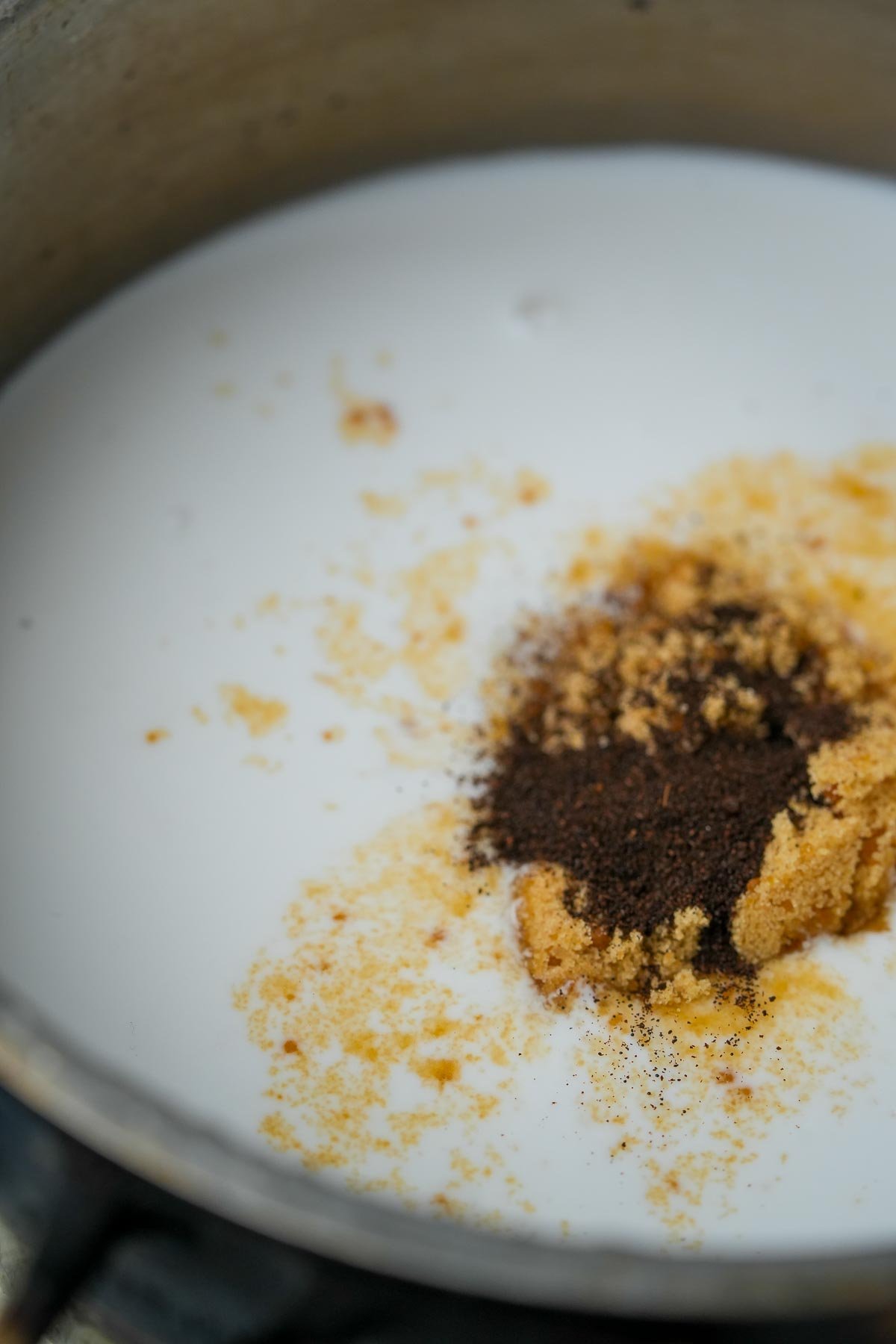
Step Four
Creamy & Dreamy:
In a small saucepan, warm the coconut cream over low heat. Stir in the coconut sugar and optional vanilla powder until fully dissolved. Remove from heat and let it cool completely in a refrigerator for at least one hour.

Step Five
Perfect Pearls:
In a separate pot, cook the sago or tapioca pearls according to package instructions. Drain and rinse with cold water, then set aside.
✅If your package didn’t include cooking guidelines, I added some tips about cooking these in the FAQ section below.

Step Six
Frolic in a Goodies-Bonanza:
In a large mixing bowl, combine the young coconut strings, nata de coco, and sugar palm fruit. Add the cooked sago or tapioca pearls and pandan jelly cubes. Mix gently to combine.
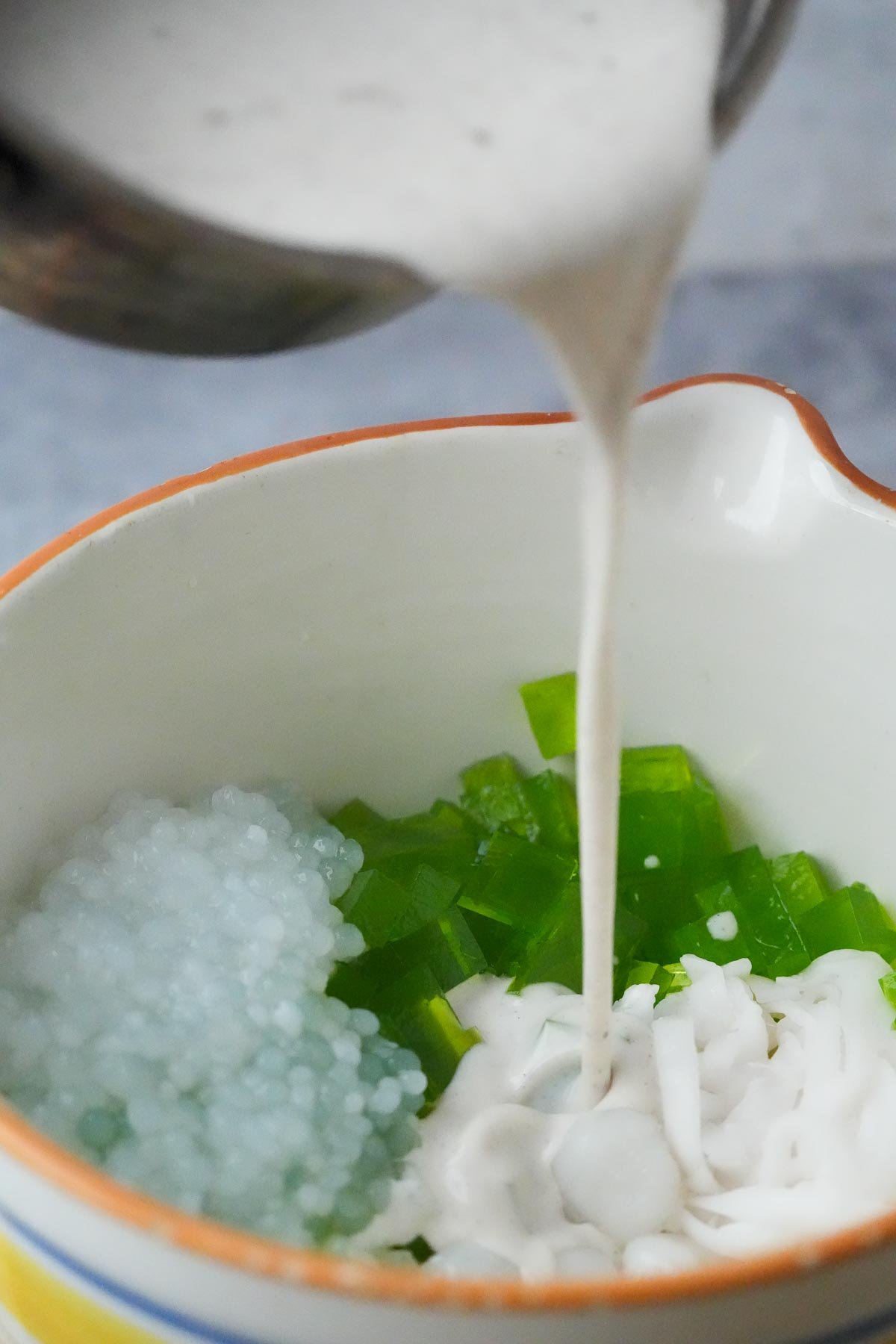
Step Seven
Final Touches:
Pour the coconut cream mixture over the combined buko salad ingredients in the mixing bowl. Stir gently to coat all the ingredients evenly.
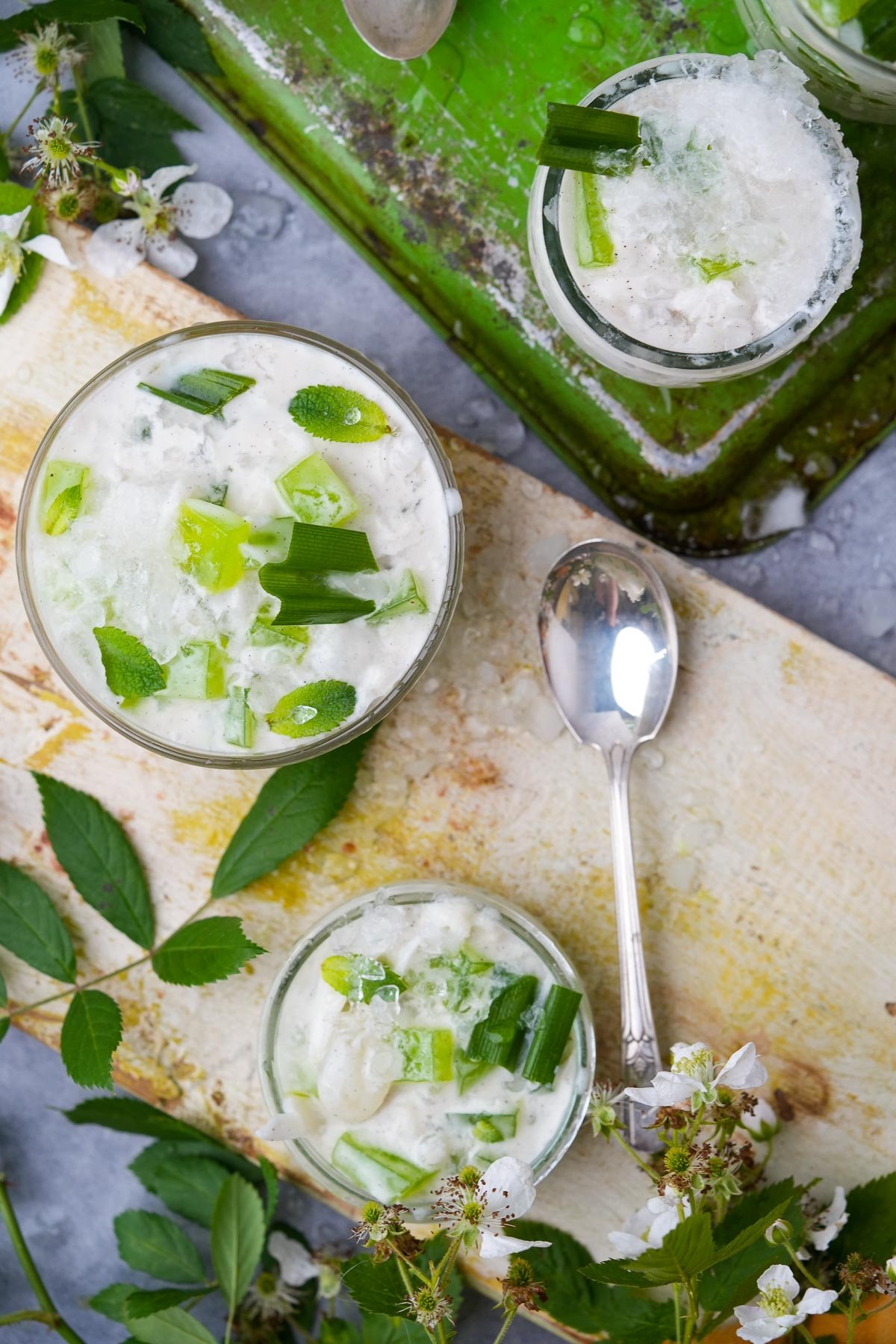
Step Eight
Serve it Up with Love:
Serve the buko pandan salad in in individual bowls, glasses, or mason jars, optionally garnished with crushed ice, sliced pandan leaves, and mint leaves.
💡Serving Ideas
Maybe I am biased, but I think a few cold desserts, like Buko Pandan, are a better finale for a great Filipino meal.
It's a superb way to follow up classics like adobong sitaw, with long beans, tofu, and jackfruit “pork”. Ensaladang talong, a Filipino charred eggplant salad, is great served alongside some ginisang munggo, tofu sisig, or ginataang kalabasa, with this cold dessert afterward.

👉Top tips
- Perfect Jelly Texture: When making the pandan jelly, ensure the agar agar is fully dissolved before pouring it into the dish. Using agar powder instead of flakes makes this easier. Stir constantly and simmer for three to four minutes over low heat to avoid graininess in the final jelly. Then make sure not to let the jelly set in too wide or too narrow of a container, so that the jelly isn’t super thin or thick. I like to use a 9x13 inch pan for this recipe.
- Don’t Screw up Your Sago Pearls: Few things suck worse than uncooked pearls. Cook the sago or tapioca pearls until they are fully translucent, but not falling apart. Rinse them under cold water to prevent them from sticking together and to stop the cooking process. Properly cooked sago pearls should be chewy, not hard or mushy.
- Balanced Sweetness: Rinse any ingredients that come in syrup well so they don’t make this dessert cloyingly sweet. Whoever controls the sugar lever at the syrup factory is friggin’ nuts! Adjust the sweetness of the coconut cream mixture to your preference. Start with the recommended amount of sugar and add more if needed, but remember that the other ingredients, such as nata de coco and kaong also add sweetness.
🤷♀️ Recipe FAQs
Store your buko salad in an airtight container in the refrigerator for up to three days. If you need to keep it longer, freezing is an option, but be aware that the texture of the nata de coco and tapioca pearls will not be as nice when thawed.
If your package of pearls didn't come with cooking instructions, you can follow these. The main thing is that they should cook until they are clear.
Small Sago Pearls:
1. Bring a pot of water to a rolling boil.
2. Add the small sago pearls and cook for 10 minutes over medium heat, stirring occasionally to prevent sticking.
3. Turn off the heat and cover the pot. Let the sago sit for another 10 minutes.
4. Drain and rinse the sago pearls under cold water until they are no longer hot to touch.
Medium Sago Pearls:
1. Bring a pot of water to a rolling boil.
2. Add the medium sago pearls and cook for 15 minutes over medium heat, stirring occasionally to prevent sticking.
3. Turn off the heat and cover the pot. Let the sago sit for another 15 minutes.
4. Drain and rinse the sago pearls under cold water until they are no longer hot to touch.
Notes for Tapioca Pearls:
- Tapioca pearls can be treated similarly to sago pearls, but they often require a longer cooking time.
- For small tapioca pearls, cook for 15 minutes, let sit for an additional 15 minutes.
- For medium tapioca pearls, cook for 20 minutes, let sit for an additional 20 minutes.
- Always rinse under cold water after cooking to stop the cooking process and prevent them from sticking together.
You can use fresh pandan leaves to make a substitute for pandan extract. Simmer the coconut water used in the pandan jelly with a few fresh or frozen knotted pandan leaves. Blend and strain the mixture before cooking with the agar agar.
If your pandan jelly is not setting, it’s likely because the agar agar wasn’t fully dissolved. Make sure to simmer the mixture for three to four minutes, stirring constantly, to ensure the agar agar completely dissolves.
Yes, if you want to avoid the saturated fat that coconut contains, you can use other unsweetened plant-based milks such as almond, oat, or soy milk, but it’s not going to be quite as rich and lovely. Coconut cream provides the best consistency and flavor for this dessert.
To prevent sago pearls from sticking together, rinse them under cold water immediately after cooking and drain them well. This stops the cooking process and removes excess starch. Make sure to get them into the coconut cream sauce for this dessert quickly, so they don’t start to merge into a science fiction blog creature from a crystalline holographic galaxy that will scare your children.
✌️A few other great sweets to serve with vegan buko pandan:
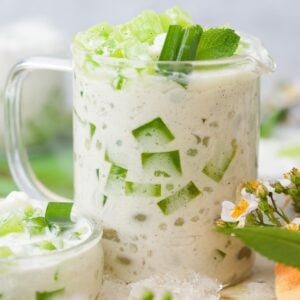
Buko Pandan Salad Dessert
Ingredients
Pandan Jelly:
- 2 cups coconut water
- ½ teaspoon pandan extract
- ¼ teaspoon salt
- 2 teaspoons agar agar powder
- 3 tablespoons sugar
Coconut Cream:
- 13.5 oz. can of coconut cream
- 2 tablespoons coconut sugar palm sugar, or brown sugar
- ¼ teaspoon vanilla powder optional
The Goodies:
- ½ cup sago or tapioca pearls medium-sized
- 1 cup young coconut strings rinsed and drained
- ½ cup nata de coco rinsed and drained
- ½ cup sugar palm fruit in syrup Kaong, rinsed and drained
Optional Garnishes:
- Crushed ice
- Sliced pandan leaves
- Mint leaves
Instructions
- In a medium saucepan, combine coconut water, pandan extract, salt, agar agar powder, and sugar. Bring to a boil over medium heat, stirring frequently. Once boiling, reduce heat to low and simmer for 3-4 minutes, continuing to stir until the agar agar powder is fully dissolved. Pour the mixture into a 13x9 inch pan and let it cool to room temperature.
- Once set, cut the jelly into small cubes.
- In a small saucepan, warm the coconut cream over low heat. Stir in the coconut sugar and optional vanilla powder until fully dissolved. Remove from heat and let it cool completely in a refrigerator for at least 1 hour.
- In a separate pot, cook the sago or tapioca pearls according to package instructions. Drain and rinse with cold water, then set aside.
- In a large mixing bowl, combine the young coconut strings, nata de coco, and sugar palm fruit. Add the cooked sago or tapioca pearls and pandan jelly cubes. Mix gently to combine.
- Pour the coconut cream mixture over the combined ingredients in the mixing bowl. Stir gently to coat all the ingredients evenly.
- Serve the Buko Pandan in individual bowls, glasses, or mason jars, optionally garnished with crushed ice, sliced pandan leaves, and mint leaves.
Notes

Enter your email & I'll send it to your inbox. Plus, get great new recipes from me every week!
By submitting this form, you consent to receive emails from Cinnamon Snail.

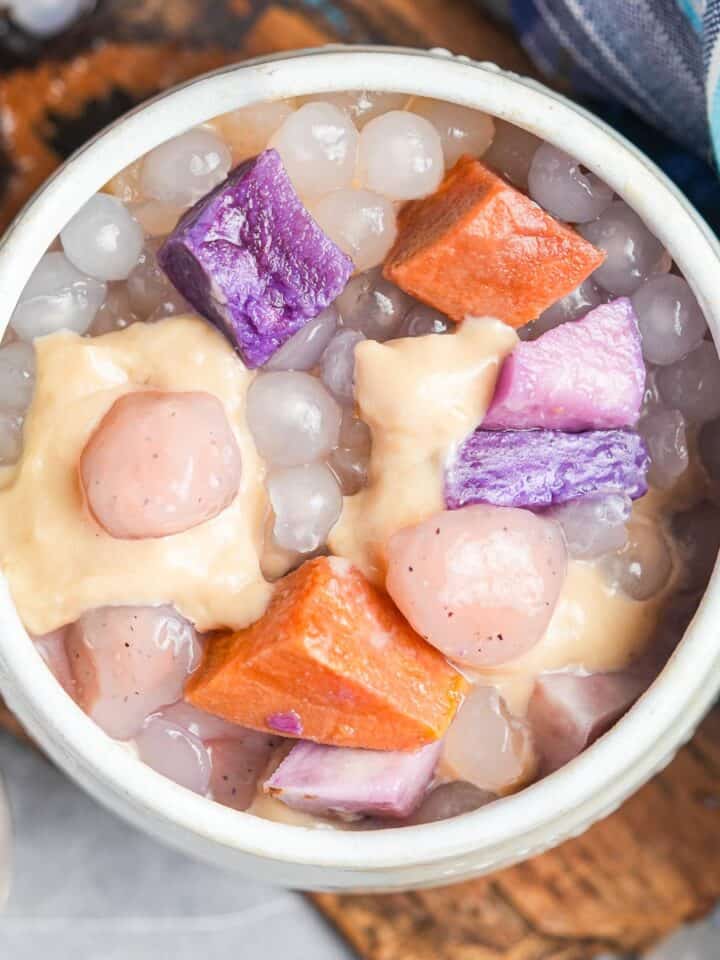

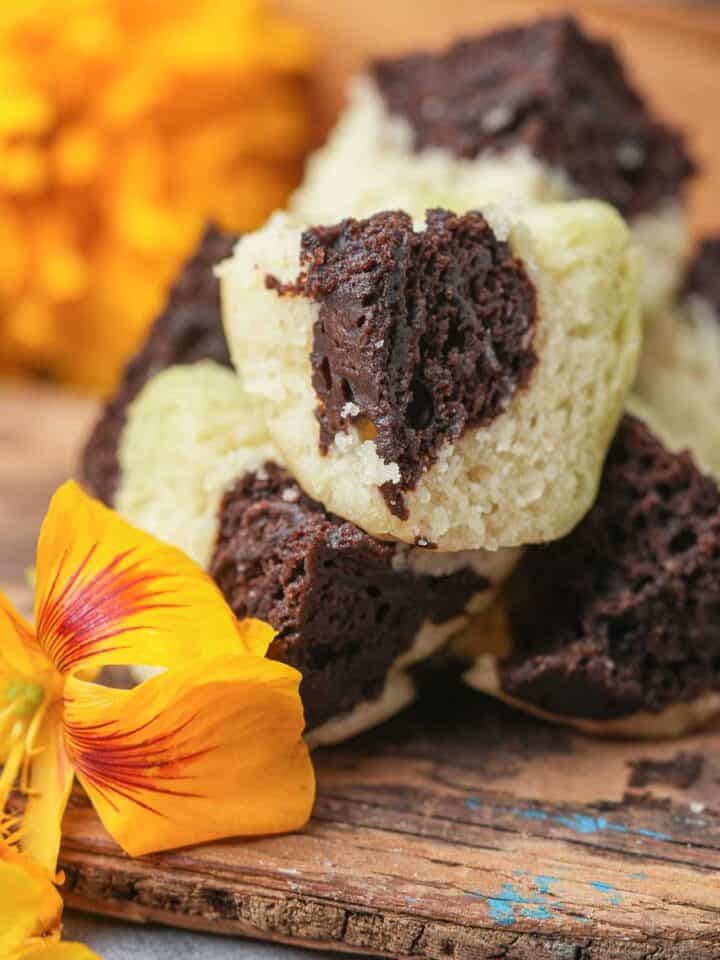
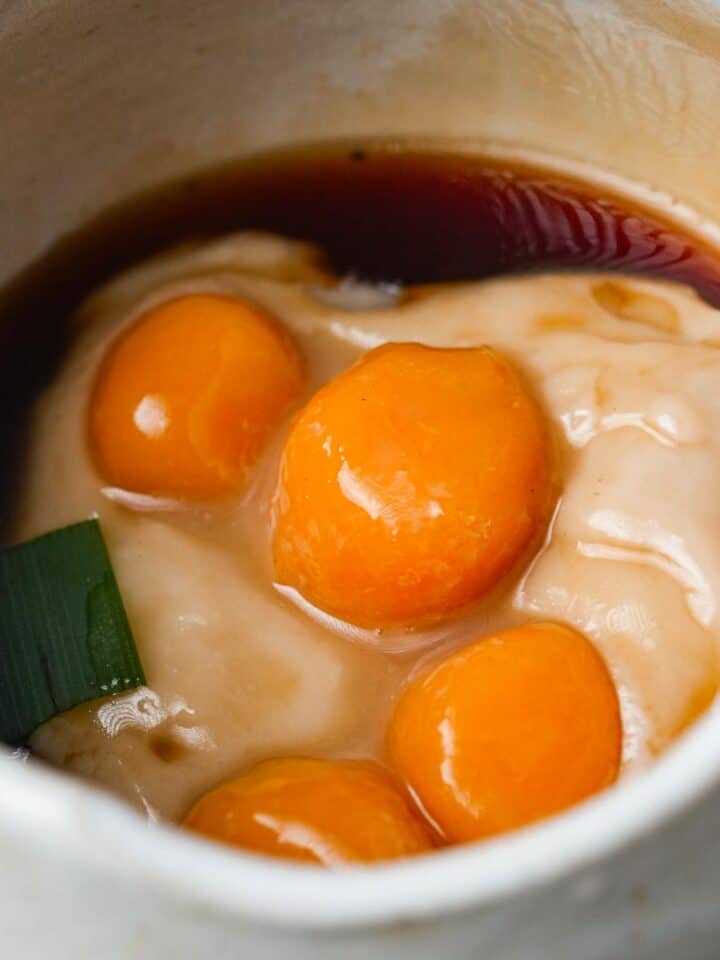


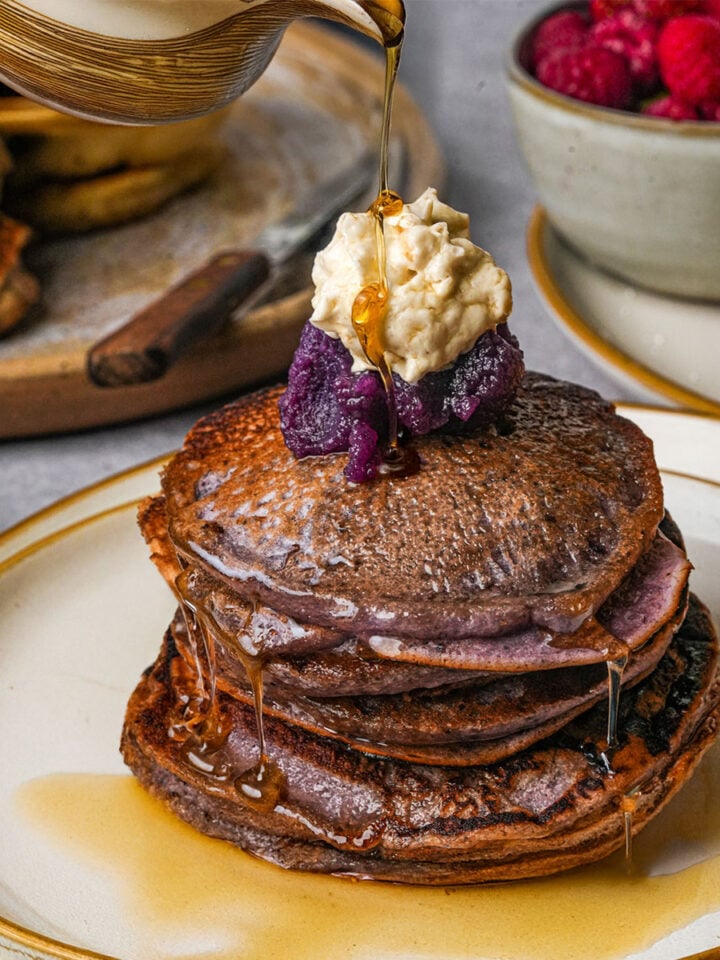



Alexis Rodrigo says
Yummm! Now I don’t have to be deprived of an old favourite anymore! Even my non-vegan family agrees this is delicious. I added a drop of green food colouring because my pandan extract is clear. Other versions of this recipe call for coconut condensed milk, which makes it too sweet for me. Surprisingly, the few tablespoons of sugar in this recipe are just right. Thank you, Adam, for another great recipe!
Adam Sobel says
So glad you loved it, Alexis? Any other fave Filipino desserts you would like me to veganize? I am planning to do a Halo Halo at some point.
Alexis Rodrigo says
Oh yes, halo-halo please! And how about leche flan??? It’s made with egg yolks and milk, so good luck with that! 😁
Adam Sobel says
I have a couple other flans already veganized on thi blog. For sure I would need to make a Filipino-style one for halo halo, but I already have a Vietnamese one here, so I don't think it would be too crazy.